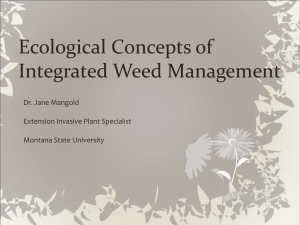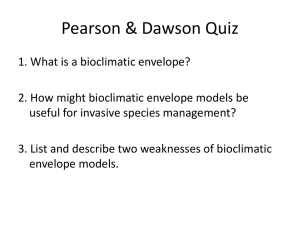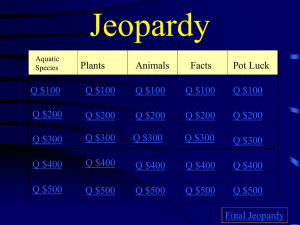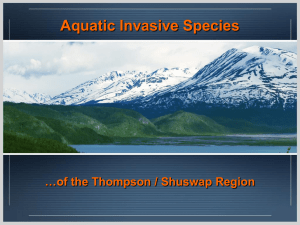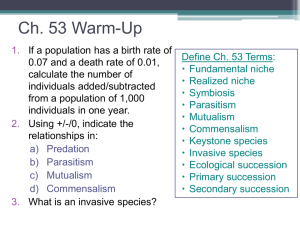invasion
advertisement
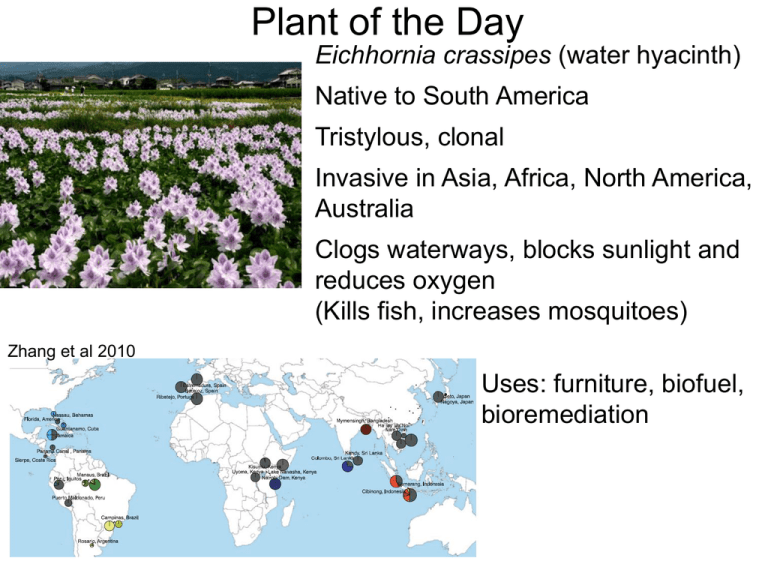
Plant of the Day Eichhornia crassipes (water hyacinth) Native to South America Tristylous, clonal Invasive in Asia, Africa, North America, Australia Clogs waterways, blocks sunlight and reduces oxygen (Kills fish, increases mosquitoes) Zhang et al 2010 Uses: furniture, biofuel, bioremediation “Any plant that crowds out cultivated plants” “A plant that grows where it is not wanted” “A plant out of place” What is a weed? “A plant is a weed if…its populations grow entirely or predominantly in situations markedly disturbed by man.” - HG Baker, 1965 weed = colonizer / ruderal “Natural experiments” in plant evolution Colonization = opportunity for adaptation to novel environments “Natural experiments” in plant evolution Agricultural weeds Derived from wild species / other crops • Adaptation to crop environment • Opportunities for repeated evolution of weedy forms • Gene flow / hybridization with progenitors Colonizers Associated with Humans • Weedy: Human disturbance • Introduced: Human-assisted dispersal -introduced, alien, exotic, non-indigenous, or non-native species -about 1/4 of vascular plant species in Canada are introduced (1,229 species) • Invasive: Rapid spread and dominance -annual costs of invasive plants to the agricultural community are estimated at $2.2 billion (496 are invasive) “Natural experiments” in plant evolution Introduced species Transferred outside range of natural dispersal • Founder effects? • Adaptation? > spread / invasion > range limits = NOT just colonizers of disturbed areas WEEDS Founding events: Genetic variation lost Loss 25 Gain in Variation (Multiple introductions) 20 Average = loss of 19% 15 # Species 10 5 0 -1 -0.2 0.2 1 2 Proportional Change of He in Introduced Populations [(introduced – source) / source] 3 Founding events • Genetic bottlenecks probably common • Non-random mating/asexual reproduction common selfing apomixis (asexual seeds) vegetative spread •Genetic Drift Founding events We know genetic bottlenecks can have fitness costs Decline in Hatching Success vs. Source Populations Number of Birds Introduced Founding events Loss of Inbreeding depression in Hypericum canariense 1 Inbreeding depression for germination δ = outcross – self self 0.5 Hawaii San Diego, California older cohorts 0 -0.5 recent cohorts -1 Invasion Leading Core Edge Invasion Leading Core Edge Adaptation in Introduced Populations Depends on: Genetic variation Selection Extinction risk (population growth, r) r>0 r<0 r << 0 Niche axis 1 Introductions Niche axis 2 Niche axis 2 New niche A B Niche axis 1 C D Simulation with demographic stochasticity Niche axis 2 Adaptation in Introduced Populations A B C D Niche axis 1 Adaptation occurs ** NOT required for invasion Holt et al. 2005 Simulation with demographic stochasticity Niche axis 2 Adaptation in Introduced Populations A B C D Niche axis 1 Adaptation beneficial Produces invasion lag Holt et al. 2005 Simulation with demographic stochasticity Niche axis 2 Adaptation in Introduced Populations A B C D Niche axis 1 Adaptation required Produces invasion lag Holt et al. 2005 Simulation with demographic stochasticity Niche axis 2 Adaptation in Introduced Populations A B C D Niche axis 1 Adaptation too slow to prevent extinction **hard to study failed introductions Holt et al. 2005 Adaptation in Introduced Populations Punchline The relative difference in environments (niches) occupied by native and invading populations will dictate: • Extinction risk • Whether adaptation needed for establishment • Whether adaptation needed for invasion Evolution and invasion What type of evolutionary changes occur during invasion? Could these changes contribute to “invasiveness”? Observation: many plant species grow larger and have greater reproduction and spread more rapidly in the invaded range compared to the native range (Crawley 1987). Why? Enemy release hypothesis Evolution of increased competitive ability Evolution and invasion 1. Plants trade off investment in self-defence for increased investment in growth and reproduction in the invasive range. 2. Plants trade off tolerance to abiotic stresses in native range for increased competitive and/or colonizing ability. 3. Invasive plants have greater vigor due to hybridization (e.g. heterosis, adaptive introgression, transgressive segregation). Common Ragweed (Ambrosia artemisiifolia) 1. Do invasive populations have higher growth and reproduction in benign environments compared to native populations? 2. Is any advantage of the invasive populations lost in stressful conditions- i.e. is there evidence for a trade-off? Goal: compare growth rates, reproductive outputs, stress responses of native and invasive populations of ragweed in common gardens. Common Ragweed (Ambrosia artemisiifolia) Wind pollinated, self incompatible monecious annual Problematic weed native to North America (sunflower, soybean, corn) Invasive in parts of Australia, Asia and Europe (e.g. 80% of arable land in Hungary is infested) Severely allergenic (hayfever, dermatitis) Distribution of Ambrosia over the last 15 000 yrs Native to North America Common in the great plains for the past 15 000 yrs Distribution of Ambrosia over the last 15 000 yrs Native to North America Common in the great plains for the past 15 000 yrs Distribution of Ambrosia over the last 15 000 yrs Native to North America Common in the great plains for the past 15 000 yrs Distribution of Ambrosia over the last 15 000 yrs Native to North America Common in the great plains for the past 15 000 yrs Distribution of Ambrosia over the last 15 000 yrs Native to North America Common in the great plains for the past 15 000 yrs Distribution of Ambrosia over the last 15 000 yrs Native to North America Common in the great plains for the past 15 000 yrs Distribution of Ambrosia over the last 15 000 yrs Native to North America Common in the great plains for the past 15 000 yrs Distribution of Ambrosia over the last 15 000 yrs Native to North America Common in the great plains for the past 15 000 yrs Distribution of Ambrosia over the last 15 000 yrs Native to North America Common in the great plains for the past 15 000 yrs Common garden experimental design 12 invasive, 22 native populations grown in UBC glasshouse Experiment 1 - 1278 plants •6.4 families/native population •9.6 families/invasive population •Control, light, nutrient, herbivory stress •3 blocks Experiment 2 - 180 plants •3.8 families/native population •8.1 families/invasive population •Drought stress Initial differences between the native and introduced range Two weeks after germination One week after transplant Invasive plants are larger than native plants Biomass •There is a significant range*treatment interaction for biomass •Invasive plants tend to grow larger in the control and light stress •More equivalent growth in the nutrient stress Reproductive success •The invasive plants flowered more frequently and had greater reproductive biomass in all treatments Drought Experiment •Invasive plants wilted and died more quickly than native plants Conclusions 1. Do invasive populations have higher growth and reproduction in benign environments compared to native populations? Invasive plants grow larger and have greater reproductive success in benign and some stressful environments 2. Is any advantage of the invasive populations lost in stressful conditions- i.e. is there evidence for a trade-off? Invasive plants have poor survival under drought conditions (abiotic stress) compared to native plants suggesting a trade-off for drought stress


